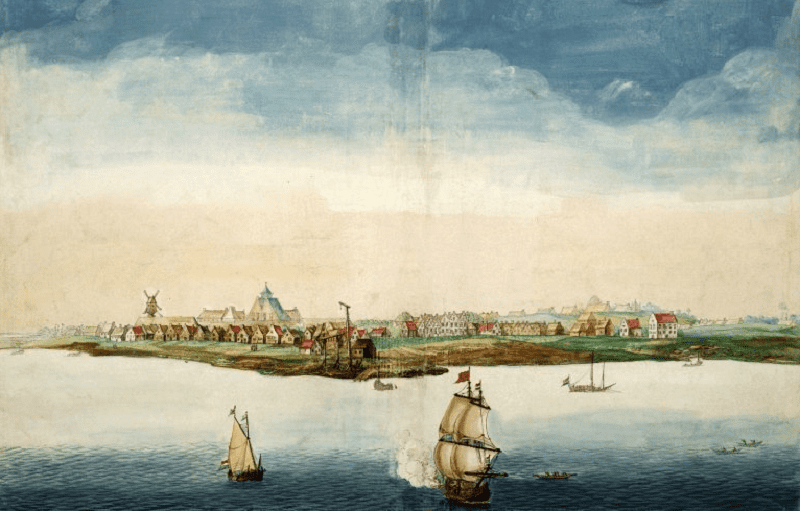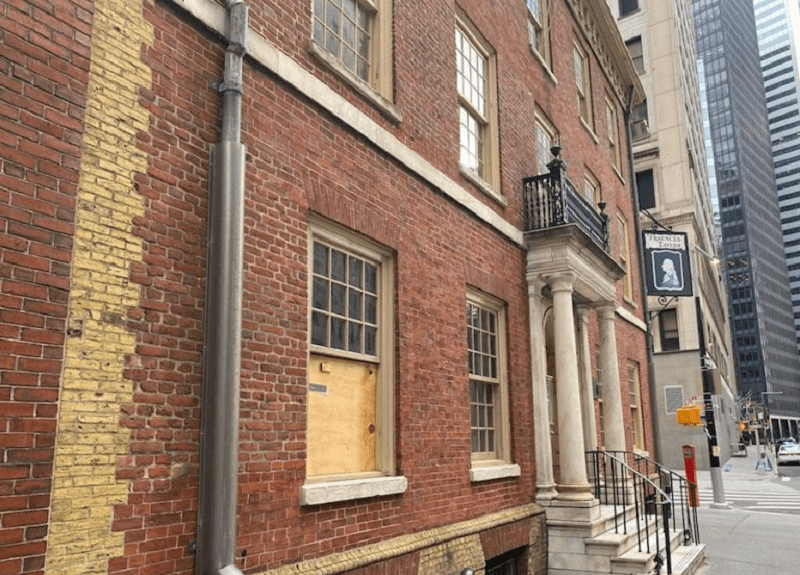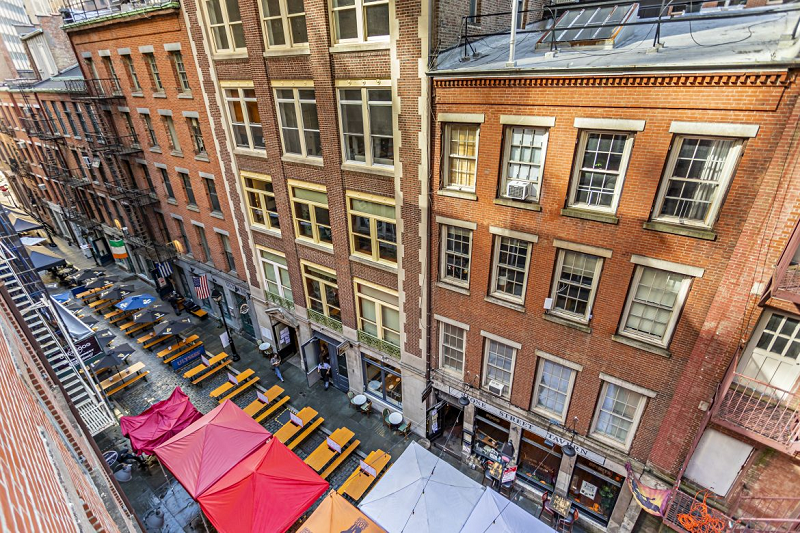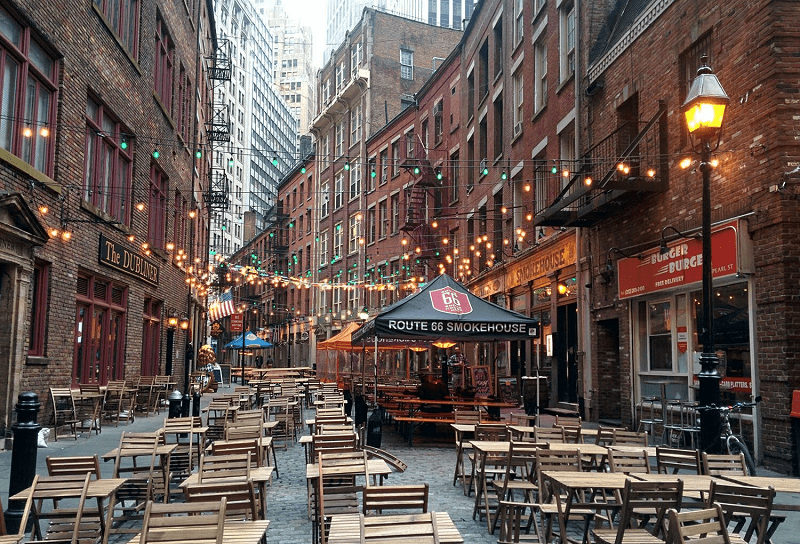Stone St in Manhattan is a short street in the middle of the financial district of NYC. The street is on the territory of two sections between such streets as Whitehall on the western part and Hanover Square on the eastern part. This street was founded as a straight roadway from the neighboring Whitehall and Hanover Square, but later it changed its function due to the elimination of the section between Broad St and Coenties Alley in 1980. This was done for the Goldman Sachs building project at 85 Broad St. Read more on manhattan-future.
The main function of the western part of the street (between Whitehall and Broad streets) is to ensure continuous and convenient traffic flow in Manhattan. At the same time, the eastern part of the street has become a safe zone for pedestrians. The following is the history of one of the main streets of Manhattan, Stone St.
The Dutch colonial era
Stone St is a very old and historic street in NYC. Its construction began with the foundation of New Amsterdam by the Dutch West India Company in 1624. The street has colonial components: Brewer St, Broad St and Hoogh St. This formed a large and long road that passed the Peck Slip ferry (the modern South St Seaport). According to the project, the streets were connected by a bridge that spanned the bay in the central part of Broad St. The surface of the original street was 6.5-7 feet (or 2 meters) lower than it is today.
The name of the street comes from its geographical location, as it was on the lower part of the city’s waterfront, with the southern part surrounded by the East River and the northern part lying through Bloemmaert’s (Company Vly) swamp. Hoogh St (the name of the street in that era) also ran through Hanover Square, and until modern times, Pearl St runs through it.

[Photo source: https://www.thewallStexperience.com/]
In 1642, the Dutch West India Company drew up two rows of plots of land. They were granted to property owners, and one of these plots was allocated to Wessel Evertsen, Thomas Willett and Richard Smith. In 1656, it was decided to shift the street 20-25 feet (or 6-7.6 meters) to the north to align it with Brewer St. Later, the street was paved. In 1660, the Castello plan was applied. It was noticed that the houses on this street were generally gabled.
The British and postcolonial era
The 17th century marked the beginning of a new era in the development of Manhattan’s Stone St. In 1664, New Amsterdam was captured by the British and later renamed New York by their decision. In 1677, the names of famous streets in the city were renamed, and the more modern High St and Stony (or Stone) St appeared.
At that time, one of the neighboring streets had eleven houses in good condition. By the end of that century, many British merchants had moved to the neighboring High St, so the neighborhood was called the English Quarter. The British were attracted to the neighborhood because of its proximity to the Coenties Slip fish market and the Old Slip meat market.
The artisan, merchant and printer William Bradford was registered as a resident of this street in 1703. Along with this famous person, there were eight colonial families who owned land on this street, and several Jewish families who were officially landowners as well. In 1704, a gutter was built on Stone St to provide better drainage.

[Photo source: https://www.thewallStexperience.com/]
The Great Fire and Reconstruction
On December 16, 1835, a great tragedy struck NYC. The Great Fire started in a warehouse near the city. Later, it began to spread rapidly due to the strong winds of that day. As a result of the fire, most of the buildings in the area were damaged or destroyed. The fire covered up to 13 acres (or 53,000 m2), and up to 700 buildings in the First District were destroyed. Following the tragedy, real estate prices in the area of the fire skyrocketed, forcing wealthy residents to sell their plots and move to other areas.
In 1836, a major phase of reconstruction of the entire financial district in the city began. More than 600 buildings on Stone St were rebuilt, and there were cases of rebuilding four-story commercial buildings of the Greek Revival period. The designs of these buildings were created by highly qualified Manhattan architects. Later, they either sold them to builders or supervised the construction themselves. There were no specific architects and builders for the buildings. Different professionals worked on each building.

[Photo source: https://www.elliman.com/]
By the end of the 19th century, nothing much had changed on Stone St. Most of the commercial buildings on the street remained four stories high. By the 1890s, some individual buildings on Stone St had undergone additions and expansions, with floors added to mid-rise buildings (up to 6-8 in total). In the spring of 1890, the street was paved with Belgian blocks.
Early and mid-20th century
In the 20th century, the Dutch Colonial Revival style spread to Stone St. One of the wealthy landowners of the time, Amos R. Eno, purchased houses on the street in Manhattan’s financial district. Later, by the decision of his son, Amos R. Eno, C.P.H. Gilbert was hired in 1903 to reconstruct the buildings at 57 Stone St. At his request, the Dutch Colonial Revival style was to be used, a similar order he made in 1908 for the building at 55 Stone St. The famous merchant Henry Schaefer also hired Edward L. Tilton to design a new house on the land at 53 Stone St in the same style.
All other large buildings in this financial district of Manhattan consisted of 18-story buildings at 24-26 Stone St. One of them was built in the early 20th century, and the reconstruction phase of another 11-story building, located at 1 William St, was completed in 1907.

[Photo source: https://www.anuevayork.com/]
During the First World War, nothing much changed on this street. After the war, a large number of small buildings were constructed, some financed by marine insurance companies. The Chubb & Son company hired Arthur C. Jackson, who in 1919 was to design a Neo-Renaissance façade. This facade was to be placed on the existing building at 54 Stone St. At 25, 27-29, and 39-43 Stone St, there were groups of buildings of eight floors, constructed from 1918 to 1921 by Wm. H. McGee & Co, which hired William Neil Smith. He was involved in the construction of some of the buildings on the street.
In the 20s of the 21st century, Stone St is an important, albeit small, street in the middle of Manhattan’s financial district. It is home to large historic buildings, including the National Historic Landmark at 1 Hanover Square. The eastern part of the street is designated as historic, and the entire Stone St Historic District was listed on the National Register of Historic Places, which continues to be protected by the New York City Landmarks Preservation Commission. It can be argued that this street is a landmark of the entire city.